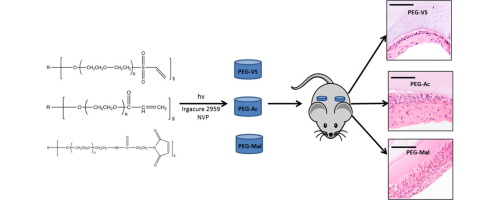Acta Biomaterialia ( IF 9.4 ) Pub Date : 2017-12-12 , DOI: 10.1016/j.actbio.2017.12.007 James R Day 1 , Anu David 1 , Jiwon Kim 1 , Evan A Farkash 2 , Marilia Cascalho 3 , Nikola Milašinović 4 , Ariella Shikanov 5

|
Poly(ethylene glycol) (PEG) can be functionalized and modified with various moieties allowing for a multitude of cross-linking chemistries. Here, we investigate how vinyl sulfone, acrylate, and maleimide functional end groups affect hydrogel formation, physical properties, viability of encapsulated cells, post-polymerization modification, and inflammatory response of the host. We have shown that PEG-VS hydrogels, in the presence of a co-monomer, N-vinyl-2-pyrrolidone (NVP), form more efficiently than PEG-Ac and PEG-Mal hydrogels, resulting in superior physical properties after 6 minutes of ultraviolet light exposure. PEG-VS hydrogels exhibited hydrolytic stability and non-fouling characteristics, as well as the ability to be modified with biological motifs, such as RGD, after polymerization. Additionally, unmodified PEG-VS hydrogels resulted in lesser inflammatory response, cellular infiltration, and macrophage recruitment after implantation for 28 days in mice. These findings show that altering the end group chemistry of PEG macromer impacts characteristics of the photo-polymerized network. We have developed a tunable non-degradable PEG system that is conducive for cell or tissue encapsulation and evokes a minimal inflammatory response, which could be utilized for future immunoisolation applications.
Statement of Significance
The objective of this study was to develop a tunable non-degradable PEG system that is conducive for encapsulation and evokes a minimal inflammatory response, which could be utilized for immunoisolation applications. This study has demonstrated that reactive functional groups of the PEG macromers impact free radical mediated network formation. Here, we show PEG-VS hydrogels meet the design criteria for an immunoisolating device as PEG-VS hydrogels form efficiently via photo-polymerization, impacting bulk properties, was stable in physiological conditions, and elicited a minimal inflammatory response. Further, NVP can be added to the precursor solution to expedite the cross-linking process without impacting cellular response upon encapsulation. These findings present an additional approach/chemistry to encapsulate cells or tissue for immunoisolation applications.
中文翻译:

聚乙二醇大分子单体的官能团对光聚合水凝胶的物理性质和宿主中局部炎症反应的影响。
聚(乙二醇)(PEG)可以进行功能化和修饰,具有多种结构,可以实现多种交联化学。在这里,我们调查乙烯基砜,丙烯酸酯和马来酰亚胺功能端基如何影响水凝胶的形成,物理特性,封装的细胞的活力,聚合后的修饰和宿主的炎症反应。我们已经证明,在共聚单体N-乙烯基-2-吡咯烷酮(NVP)存在下,PEG-VS水凝胶比PEG-Ac和PEG-Mal水凝胶更有效地形成,在6分钟后产生了优异的物理性能紫外线的照射。PEG-VS水凝胶在聚合后表现出水解稳定性和不结垢特性,以及被生物基序修饰的能力,例如RGD。此外,未经修饰的PEG-VS水凝胶在小鼠体内植入28天后导致较小的炎症反应,细胞浸润和巨噬细胞募集。这些发现表明,改变PEG大分子单体的端基化学性质会影响光聚合网络的特性。我们已经开发了一种可调节的不可降解的PEG系统,该系统有利于细胞或组织的包裹并引起最小的炎症反应,可用于未来的免疫分离应用中。
重要声明
这项研究的目的是开发一种可调谐的不可降解的PEG系统,该系统有利于封装并引起最小的炎症反应,可用于免疫分离应用。这项研究表明,PEG大分子单体的反应性官能团会影响自由基介导的网络形成。在这里,我们显示PEG-VS水凝胶符合免疫隔离装置的设计标准,因为PEG-VS水凝胶通过光聚合有效形成,影响整体性质,在生理条件下稳定,并引起最小的炎症反应。此外,可以将NVP添加到前体溶液中以加快交联过程,而不会影响封装时的细胞反应。











































 京公网安备 11010802027423号
京公网安备 11010802027423号